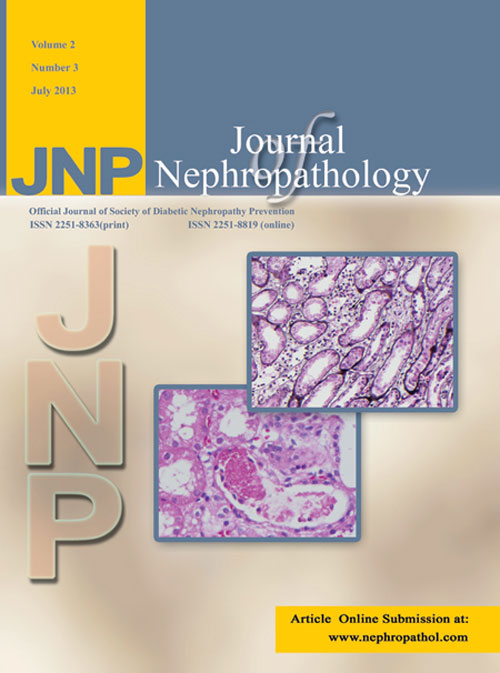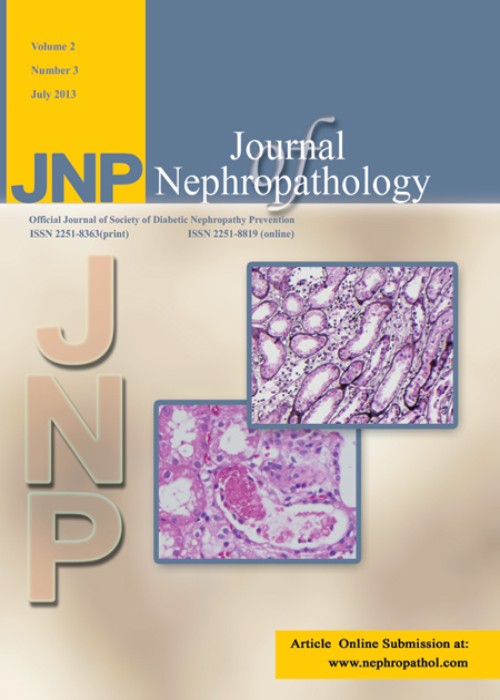فهرست مطالب

Journal of nephropathology
Volume:7 Issue: 1, Jan 2018
- تاریخ انتشار: 1396/12/09
- تعداد عناوین: 11
-
Pages 1-3Implication for health policy/practice/research/medical education:Hydrogen sulfide plays an important role in renal pathology and shows the protective role under pathological conditions in some of experimental models of renal disease.Keywords: Sodium Hydrogen Sulfide, H2S, Renal pathology, Acute kidney injury
-
Pages 4-6Context: Chronic kidney disease (CKD) is a worldwide public health problem and its occurrence and prevalence are on the rise. One of the populations with an increase in the occurrence of CKD is women. .In this study we reviewed previous studies in order to investigate main concern in women with CKD.
Evidence Acquisition: PubMed, EBSCO, Embase Web of Science, directory of open access journals (DOAJ), Scopus, and Google Scholar have been searched.ResultsMain concerns in women with CKD are including menstruation irregularity and dysfunction, decreased sexual desire, high-risk pregnancy, prenatal and fetal complications, early menopause and vitamin D deficiency.ConclusionsWomen need to special attention due to some physical and physiological differences such as hormonal difference, menstruation period, pregnancy and menopause. Patients education and awareness of health care personnel are very effective in achieving the goals.Keywords: Chronic kidney disease_Vitamin D_Vitamin D deficiency_Menopause_Menstruation_World kidney day 2018??? -
Pages 7-10Context: IgA nephropathy (IgAN) as an autoimmune disease is the most common cause of glomerulonephritis worldwide. Rituximab effectively depletes B cells and reduces serum levels of IgA1 antibodies. This paper aimed to review the potential benefit of rituximab used in clinical practice of IgAN patients.
Evidence Acquisitions: PubMed, EBSCO, Web of Science, directory of open access journals (DOAJ), EMBASE, and Google Scholar were searched for the keywords of IgA nephropathy, rituximab, B cell depletion and autoimmune diseases.ResultsRituximab therapy improved in nephropathies and in recurrent IgAN in several studies. The mechanisms of rituximab therapy in IgAN are unknown. However, a direct effect of rituximab on podocytes by cytoskeleton stabilization is possible. Additionally a possible effect of rituximab on B cells in IgAN may lead to its beneficial impact.ConclusionsThis short-review demonstrates that rituximab therapy may be an effective treatment option in IgAN patients, particularly for histological signs of active inflammation. However, results of safety and efficacy of rituximab in IgAN are limited, and definitive conclusions will require further studies. Thus, multicenter clinical trials for safety and efficacy of rituximab therapy are necessary.Keywords: IgA nephropathy, Rituximab, B cell depletion, Autoimmune diseases -
Pages 11-14Context: Membranous nephropathy is among the most common causes of nephrotic syndrome in adults.
Evidence Acquisitions: PubMed, EBSCO, Web of Science, directory of open access journals (DOAJ), EMBASE, and Google Scholar with keywords of phospholipase A2 receptor, PLA2R, membranous nephropathy, nephrotic syndrome, idiopathic nephrotic syndrome and glomerulonephritis have been searched.ResultsThe recent finding that around 70%-80% of the idiopathic cases of membranous nephropathy express Phospholipase A2 receptor (PLA2R) in their kidney biopsies and antiPLA2R antibody in their serum was initially considered specific to the idiopathic cases. However, more recent studies have shown that while PLA2R glycoprotein expression, and anti-PLA2R antibodies, are specific to membranous nephropathy and are not seen in other glomerulonephritides, they can be as frequently expressed in certain secondary forms of membranous nephropathy.ConclusionsIn this communication we intend to briefly review the new data regarding tissue and sero-positivity for PLA2R in different types of secondary membranous nephropathy, as well as pathologic and immunofluorescence features of them as compared to the idiopathic cases.Keywords: Phospholipase A2 receptor, PLA2R, Membranous nephropathy, Nephrotic syndrome, Idiopathic nephrotic syndrome, Glomerulonephritis -
Pages 17-18Implication for health policy/practice/research/medical education: More studies are needed to characterize the associated factors in each unique culture and society for promoting the positive attitudes regarding tissue and organ transplantation for various life threatening and incurable diseases.Keywords: Religion, Organ donation, Transplantation
-
Pages 19-21BackgroundGerm cell tumors (GCTs) are the most common solid tumors in young men, with a peak incidence at 25-35 years. Approximately 50% of the testicular GCTs are pure seminomas and 50% are non-seminomas. Late relapse of testicular cancer (LRTC) is a rare disease with the incidence rate of 2.6% and is defined as >2 years interval between initial treatment and recurrence.Case PresentationWe report here a patient with nonseminomatous GCT who experienced relapse 27 years after his first diagnosis. He came with gross hematuria and huge abdominal mass. There was a giant retroperitoneal mass with invasion to the left kidney and other organs in computerized tomography. A biopsy was conducted and pathology revealed recurrence of malignant mixed nonseminoma GCT. The tumor was unresetable. Therefore patient was treated with four cycles of chemotherapy. PET scan was conducted after chemotherapy showed residue of tumor thus retroperitoneal lymph node dissection (RPLND) was done.ConclusionsWe concluded that with increasing lifespan of cancer patients, follow up of these patients for very late relapse must be conducted lifelong.Keywords: Testicular cancer, Germ cell tumors, Testicular cancer
-
Pages 22-24BackgroundMembranous nephropathy (MGN) is one of the most common glomerular disease seen among adults. However, it is a rare histological presentation in pediatric population. In contrast to MGN in adults where primary form is known to be the leading subtype of the disease, secondary cause is more prevailing in children.Case PresentationWe describe a case of an infant presenting with nephrotic syndrome (NS) and negative serology work-up. Kidney biopsy showed the picture of severe diffuse MGN confirmed by light, immunofluorescence and electron microscopy studies. "Full-house" pattern by immunofluorescence, numerous well-demarcated sub-epithelial deposits and tubuloreticular inclusions strongly suggested type V lupus nephritis.ConclusionsNS due to MGN is rarely seen in infancy. Secondary causes such as autoimmune disease or systemic infection need to be considered for appropriate management.Keywords: Nephrotic syndrome, Membranous glomerulonephritis, Lupus nephritis, Membranous nephropathy
-
Pages 25-31Context: Type 2 diabetes mellitus (T2DM) is a multi-factorial disease with several genetic and environmental factors known to be associated with the disease. Tumor necrosis factoralpha (TNF-α) acts on fat cells associated with increased insulin resistance and obesity and its increase can be associated with the prevalence of T2DM. Previous studies on the relationship between 308 G/A polymorphism in TNF-α and T2DM were not conclusive. The aim of this study was to investigate the association between 308 G/A polymorphism in TNF-α gene and T2DM using a systematic review and meta-analysis. Evidence Acquisitions: In this systematic review we searched all published studies about the association between TNF 308 G/A polymorphism and T2DM through databases such as Scopus, Science direct, PubMed and Google scholar. A fixed or random effect model was used on the basis of heterogeneity. The heterogeneity was assessed using the I2 index. We used STATA software (version 11.2) for data analysis.ResultsIn 22 selected papers, the total number of T2DM and control subject was 8485 and 8615, respectively. Odds ratios (ORs) with 95% confidence intervals(CI) for the GG genotype polymorphism 308 G/A in total, Asian populations and whites (Caucasian) were estimated as OR=0.98 (95% CI: 0.96-1.00), OR=0.96 (95% CI: 0.93 to 0.99) and OR=1.00 (95% CI: 0.97 to 1.40). The Publication Bias/or heterogeneity was observed in this study.ConclusionsThe present investigation have shown that 308 G/A polymorphism GG and GA genotypes in TNF-α gene cannot be considered as predictors of T2DM (PKeywords: Diabetes mellitus type 2, TNF, ?, 308 G, A, Polymorphism
-
Pages 32-36BackgroundChronic kidney disease (CKD) is a consequence of progressive and irreversible destruction of nephrons, mainly due to uncontrolled diabetes mellitus and high blood pressure. Ghrelin is a peptide hormone which could play a substantial role in hunger sensation, may increase body fat percentage and might adjust the long-term body weight and is mostly secreted in the stomach.ObjectivesThis study aimed to evaluate the relationship between ghrelin levels and various biochemical and demographic indices in a group of non-diabetic hemodialysis patients.
Patients andMethodsAround 39 non-diabetic patients undergoing hemodialysis in Hajar hospital at Shahrekord city were enrolled.ResultsThe mean age of patients was 57.10±20.20 years. Their mean weight was 56.65 ±16.25 kg. Their hemoglobin level mean was 10.43±1.84 g/dL. The serum ghrelin level had a positive but not significant correlation with the age, dialysis quality, dosage, calcium level, alkaline phosphatase (ALP), parathormone, vitamin D and hemoglobin in these patients.ConclusionsMore studies in this subject of hemodialysis patients to define the exact role of ghrelin in hemodialysis patients are recommended.Keywords: Ghrelin, Bone metabolism, Inflammation, Anemia, Hemodialysis -
Pages 37-42BackgroundNephropathy is the main problem of diabetes and can be classified into several phases according to the presence of albuminuria. Adenosine monophosphate-activated protein kinase (AMPK) operates as a sensor of energy charge.ObjectivesThe aim of our study was to evaluate the reno-protective properties of AMPK signaling pathway against streptozotocin (STZ)-induced nephropathy in the rat.Materials And MethodsForty male Wistar rats were randomly distributed into four groups. Group 1 was normal rats (N group); group 2 was diabetic rats (D group); group 3 received diabetic rats metformin (DM group), and group 4 received giabetic rats metformin dorsomorphin (DMD group). Serum albumin, uric acid, total protein and creatinine for estimation of renal injury were measured. Finally, the histological study was evaluated.ResultsReduction of body weight, albumin and total protein in the diabetic rat was reversed by metformin administration. Our results showed that serum uric acid and creatinine were significantly increased in diabetic rats and decreased after treatment with metformin in diabetic rats. AMPK improved the histopathology and morphological changes in STZinduced diabetic rats. Administration of dorsomorphin (AMPK inhibitor) with metformin can reverse the beneficial effects of AMPK.ConclusionsAMPK signaling pathway ameliorates diabetic nephropathy by modifications of serum albumin, uric acid, total protein, creatinine and attenuation of kidney damage.Keywords: Metformin, Creatinine, Diabetic nephropathy


